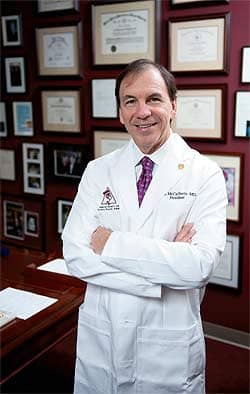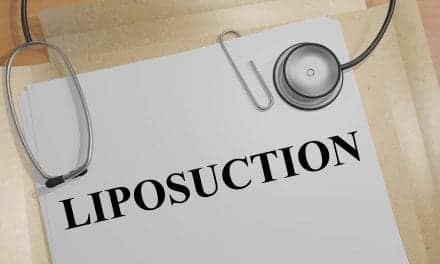Photography by R. Alan Adams

In a crowded boardroom in Vancouver, BC, Pittsburgh plastic surgeon Leo R. McCafferty, MD, began his 1-year term as president of the American Society for Aesthetic Plastic Surgery (ASAPS).
McCafferty is as understated and humble as he is accomplished and respected, but he will have his work cut out for him as he takes the helm at ASAPS.
The task at hand involves helping to reframe and reposition the specialty in light of an evolving and widening Poly Implant Prothèse (PIP) breast implant scandal in Europe and a maelstrom of negative media attention in the US. Reports of back-alley butt augmentations gone wrong, and unqualified practitioners performing cosmetic surgeries in less-than-hygienic surroundings, are common American media fodder. Some pundits are even calling for a ban on cosmetic surgery as a result of this feeding frenzy.
And the actions of what amounts to rogue few can put an entire specialty in jeopardy. “Every time we read something in the media about a liposuction death or another incident, it taints the entire specialty,” says McCafferty, who is a clinical assistant professor of plastic surgery at the University of Pittsburgh School of Medicine and the Chairman of the Board and immediate past President of the Allegheny County Medical Society. “It is a mine field out there.”
McCafferty and ASAPS’ main mission is to educate the public that in the right hands, in the right setting, and on the right patient, cosmetic surgery can have profound physical and psychosocial benefits.
SAFETY DANCE
“It is our job to stress the importance of proper credentials and only having surgery performed in a fully accredited facility, and this will continue to be a focus for us,” he says. “We must frame our message right and try and avoid the ‘plane crash’ scenario.”
But safety isn’t exciting, which is likely why the message has taken time to resonate. “We need to make our message a little more enticing so people hear it, but in the end most people appreciate the focus on safety.”
And he has a plan that starts with engaging and embracing industry. “Industry is not our enemy, they are our friends,” he says. “We need to work together toward patient safety, and we each need to understand each other’s needs. The only way to do that is through open dialogues.”

Consultations are the time to manage patient expectations.
ASAPS aims to make sure that any claims are backed by sound science, but this can be hard in the face of reality TV shows and aggressive direct-to-consumer (DTC) marketing. “The various laser companies are advertising direct to the consumer, and plastic surgeons are almost secondary,” he says.
This sets the stage for disaster because patients seek out the machinery first, with little thought to who is operating it. Many of the newer procedures are highly technician-dependent. Still, it can be hard to rein in enthusiasm for new technology once it is out there.
Make no mistake, it is out there. “Our entire society is so digitally proficient and connected,” he says. “It used to be that we read about sports in the paper once a day and watched them on the news and sports at night, but now everything is 24/7.”
Reality shows, whether Real Housewives of just about anywhere USA, Keeping Up with the Kardashians, or any of the others, as well as the morning and afternoon chat fests on all of the major networks, regularly feature plastic surgery and/or plastic surgeons. “You can’t tune in without a discussion about plastic surgery,” he says.
This can be both good and bad. “Given the instantaneous nature of the world today, it is a challenge to continue to educate our members and patients and keep everyone up on what is real and what isn’t,” he says.
This is especially true for the ever-expanding arsenal of noninvasive body-contouring surgeries. The equipment is expensive and often involves hidden, ongoing costs.
“Some work and some don’t,” he says. “We need to try to draw the science out of these companies and get answers for our members.”
To that end, he has the backing of the Aesthetic Surgery Education and Research Foundation (ASERF), a not-for-profit foundation aimed at demonstrating the effectiveness and safety of cosmetic plastic surgical procedures, devices, and techniques through directed research and physician-initiated research.
This is also where a working partnership with industry comes into play. A newly established ASAPS task force seeks to develop a code of conduct and ethics for the promotion of nonsurgical technologies and injectables that resonates with industry and cosmetic surgeons alike.

The new ASAPS president is a multitasker.
BALANCING ACT
“The ultimate consumer is the public, our patients, but the interim consumer is the one who purchases the product from the manufacturer,” says task force member and former ASAPS President Alan Gold, MD.
It’s a balancing act, says Gold, who practices in Great Neck, NY. “The type of proof that we would like to see is at a different level than the public,” he says. “We need to arrive at the best way to handle industry claims and terminology in their direct-to-consumer advertising as well as in their promotion to physicians in order to avoid confusion, misunderstanding, and the generation of unrealistic expectations among either group.”
This can be hard when the horse is already out of the gate. “It’s not about damage control, but about trying to be the voice of reason and honesty in dealing with a patient so they don’t wind up dissatisfied.”
Like McCafferty, Gold is optimistic that working with industry is the best way to achieve these lofty goals, but admits there will always be outliers who don’t want to play by anyone’s rules.
WHY CAN’T WE ALL JUST GET ALONG?
Another part of McCafferty’s plan to reposition the specialty involves encouraging members to put their swords down and do the best work they can do without engaging in turf wars with other professionals.
“We as plastic surgeons have to worry about ourselves,” he says. “We have to do it better and be the best we can be. That is what we have to concentrate on,” he says.
“We don’t need to concentrate on negativity and worrying about who else does what,” he says. “We need to work with our colleagues, including the otolaryngologists, dermatologists, and the oculoplastic surgeons. We all went to medical school and must work together where we can and compete where we choose to,” he says.

Mr President
Sientra, the manufacturer of the Silimed line of breast implants, just gave a huge vote of confidence to the specialty. Hani Zeini, the founder, president, and chief executive officer, announced that he would only sell the newly approved implants to plastic surgeons. “This is a big deal and a game changer,” McCafferty says. “This emphasizes Mr. Zeini’s commitment toward patient safety and scope of practice issues.”
LEADER OF THE BAND
McCafferty’s quiet, thoughtful demeanor, along with an ability to not just listen, but actually hear what others are saying, make him an ideal leader, but first and foremost, he is a surgeon.
And yes, being named as president of a major society is both an honor and distinction, but it does require a significant time commitment. As a result, many senior office holders have reported that their practice takes a hit during their term.
“I am not really worried about it,” he says. “I have always been heavily involved in ASAPS.”
McCafferty is also a multitasker. “The busier I am, the more efficient I am,” he says. “Whatever happens, I am fully prepared, and I will not regret one second.”
ASAPS leadership and plastic surgery aside, McCafferty is also a musician. He plays the guitar, bass, and mandolin.
Something has got to give, and of late it has been his tennis and golf games. The ex-wrestler used to play both sports often, and while he still makes time to exercise regularly, he has not had the time to devote to golf or tennis. His athletic spirit does carry over into his practice. McCafferty has served as the plastic surgeon for the men’s and women’s professional US Open Golf Championships and is the plastic surgery consultant to the Pittsburgh Steelers.
THEY ARE PENN STATE
One thing that will never fall by the wayside is his wife and four children.
Besides genes, the McCafferty clan has something else in common—their alma mater, Penn State University. He met his wife at Penn State, and all four children have either graduated or will graduate from there. In sum, “48 members of our family went to Penn State.”
That’s quite a legacy, and ASAPS colleagues are betting that their new president will also leave his mark on ASAPS and the specialty he loves.
Denise Mann is the editor of Plastic Surgery Practice. She can be reached at [email protected].




